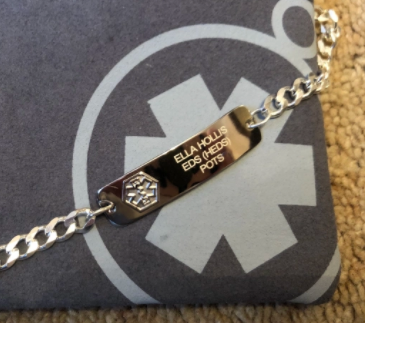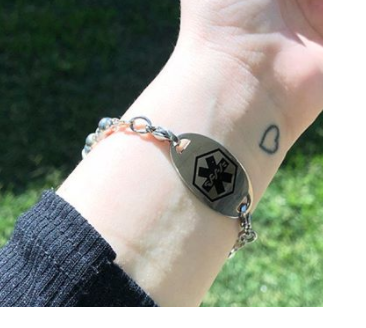

Medical IDs for Ehlers Danlos Syndrome
A medical ID is highly recommended for individuals living with Ehlers Danlos Syndrome (EDS). A person diagnosed with any form of EDS is at risk of disabling symptoms or life-threatening complications that need to be treated immediately. A person with this condition may be susceptible to Aortic and other arterial dissection and rupture, a major complication and cause of death in vascular EDS and other rare types of EDS. Simply wearing a medical ID can quickly alert others of Ehlers Danlos Syndrome and provide immediate diagnosis and treatment in an emergency.
"We recommend wearing a medical alert bracelet or necklace so the information about your diagnosis is available whenever it may be needed." - Ehlers-Danlos Support UK
Types of Ehlers Danlos Syndrome
A medical ID can swiftly communicate the presence and specific type of EDS that an individual has to emergency responders, doctors, and nurses. Personalized engraving can warn of associated risks, complications, and the special care that the wearer specifically requires.
|
|
"VEDS patients should wear an emergency medical alert bracelet, to call attention to their diagnosis, and blood type for transfusion." - Ehlers-Danlos National Foundation
Common Symptoms of Ehlers Danlos Syndrome
Depending on the type of EDS, this medical condition can affect people in different ways. The most common symptoms of EDS include problems with the joints and skin which can lead to:
- temperature sensitivity
- dizziness and fainting
- chronic fatigue
- swelling
- sprains and dislocations
- joint pain
- easy bruising
- increased risk of surgical complications

"What if I collapse when I’m out and no one knows my background? What if I’m taken for a MRI scan with no one knowing my sacral nerve stimulator isn’t MRI compatible? What if people transfer me without knowing about my connective tissue issues? Having this medical ID bracelet (from American Medical ID) really alleviates so many of my worries when I’m out and about, particularly with friends or new (& changing) carers." - Ella Hollis, Ehlers-Danlos Syndrome advocate and blogger
Medical IDs and Ehlers Danlos Syndrome in Emergencies
In an emergency, Ehlers Danlos Syndrome can be hard to identify but it is crucial to alert emergency responders of this medical condition so they can act fast. Information about EDS should prompt responders to:
- Avoid risk of subluxation or dislocation of joints when a patient is being moved
- Beware of administering chest compressions
- Recognize wound healing issues and increased risk of surgical complications
- Watch out for risks of vascular complications including aneurysm
- Carefully consider elective surgery and procedure
An EDS medical ID bracelet or necklace can ensure that your medical condition is recognized in emergencies and that you get the safe and accurate treatment that you need.
"Wear an identifying medical alert bracelet or necklace and carry an information card for emergency care." - The VEDS Movement
What to Put on an Ehlers Danlos Syndrome Medical ID


Engraved information on a medical ID bracelet or necklace for Ehlers Danlos Syndrome can be helpful to anyone responding to an emergency. When engraving an EDS alert ID, make sure that it contains accurate information that is easy to read, even in the most difficult situations when the individual is unconscious and unable to advocate for their health and safety.
- Wearer’s name
- Ehlers Danlos Syndrome or EDS – specify the type of EDS
- Life-threatening complications or risks – examples are arterial/aorta dissection, rupture and organ rupture, pneumothorax, etc.
- Other medical conditions or allergies that may or may not be related to EDS such as Dysautonomia or Postural Orthostatic Tachycardia Syndrome (POTS).
- In case of emergency contacts
An expandable wallet or emergency card for EDS can provide additional emergency information. Engrave “see wallet card” on your medical ID to prompt healthcare professionals to refer to it.

"Having a medical ID bracelet has put me in a lot better position than not having one. I've been unconscious when others are not aware of my information and this (medical ID) has literally been a lifesaver." - Amy Lee Fisher, EDS advocate and chronic illness vlogger



 - UK
- UK  - Canada
- Canada  - Australia
- Australia 